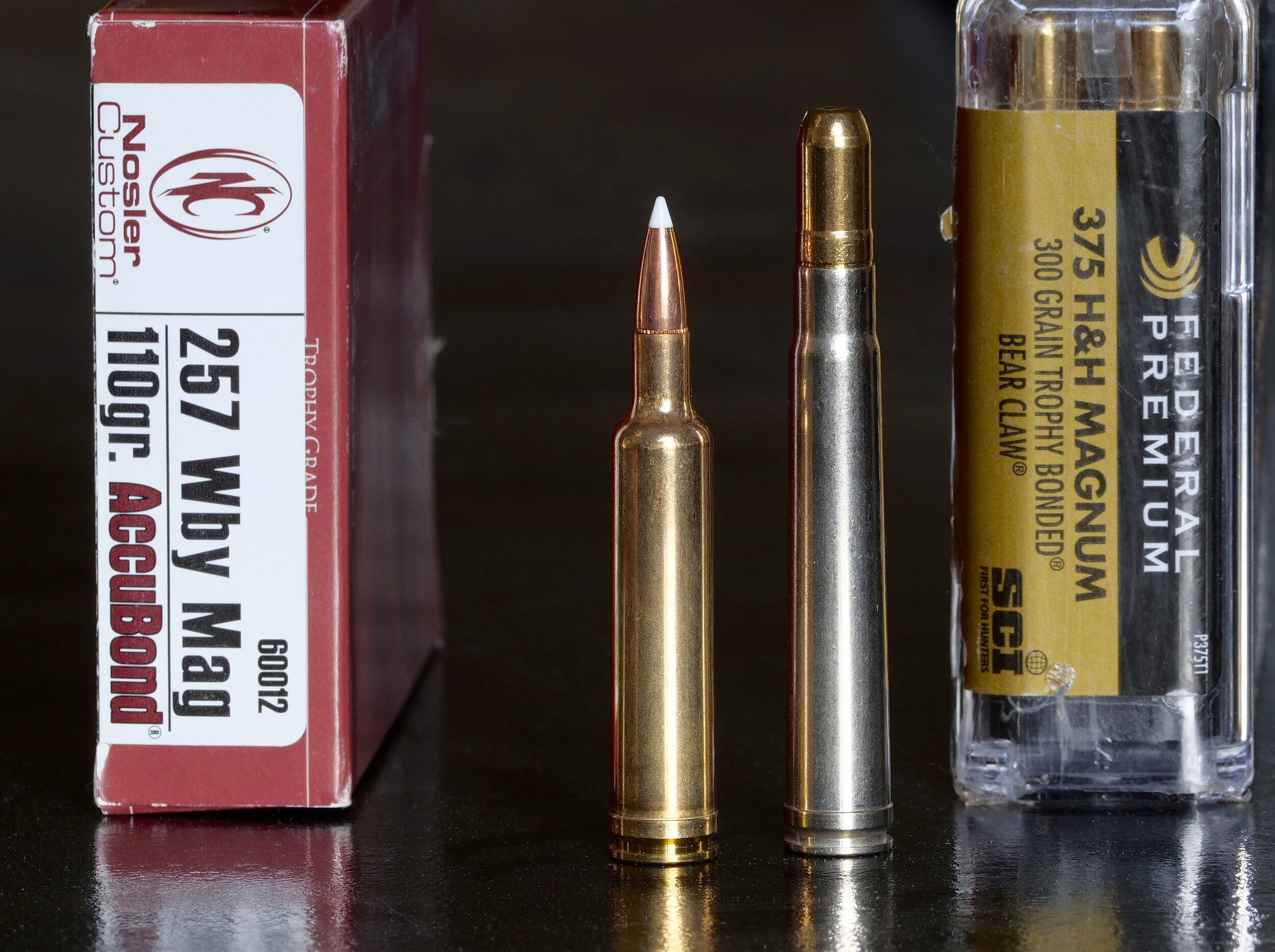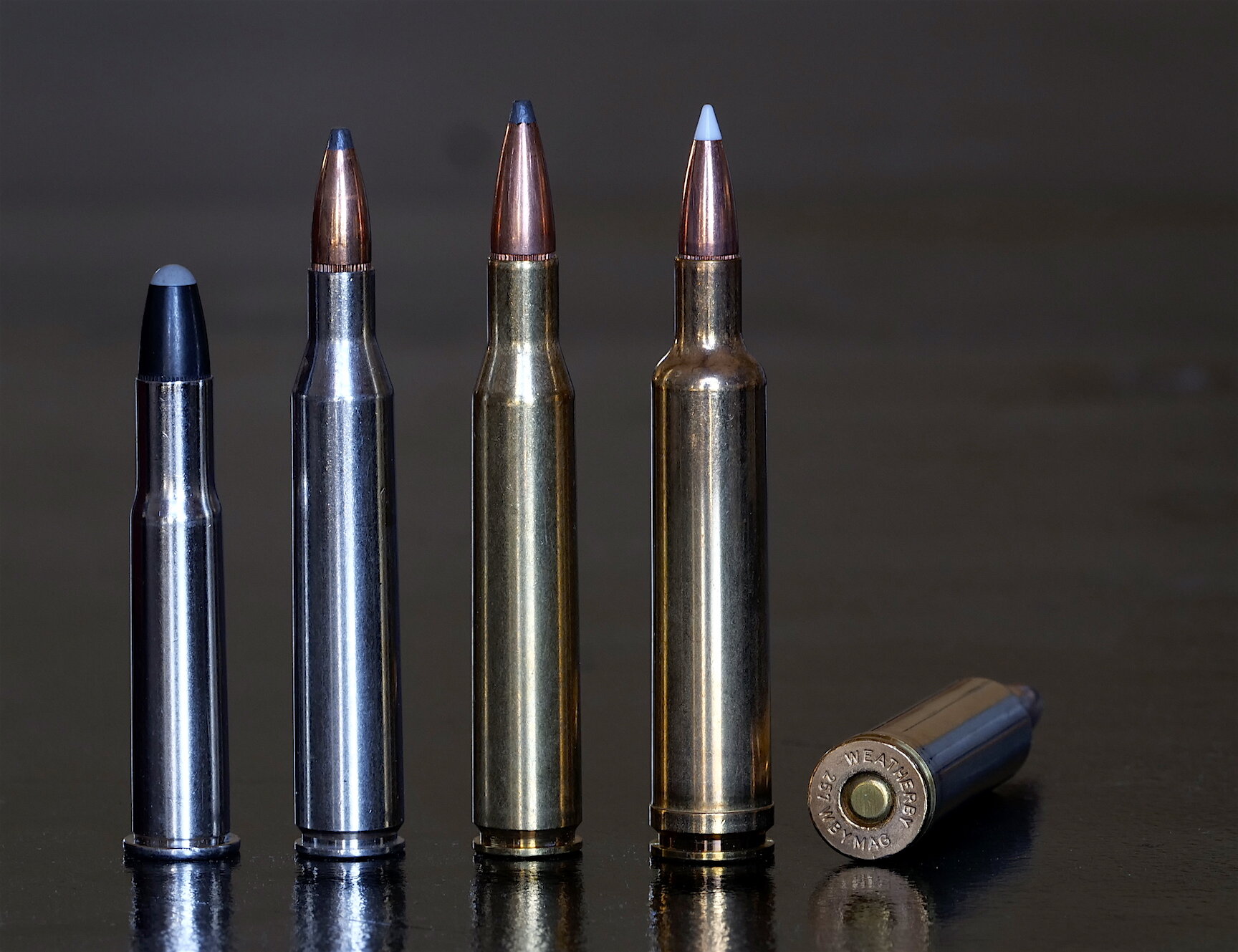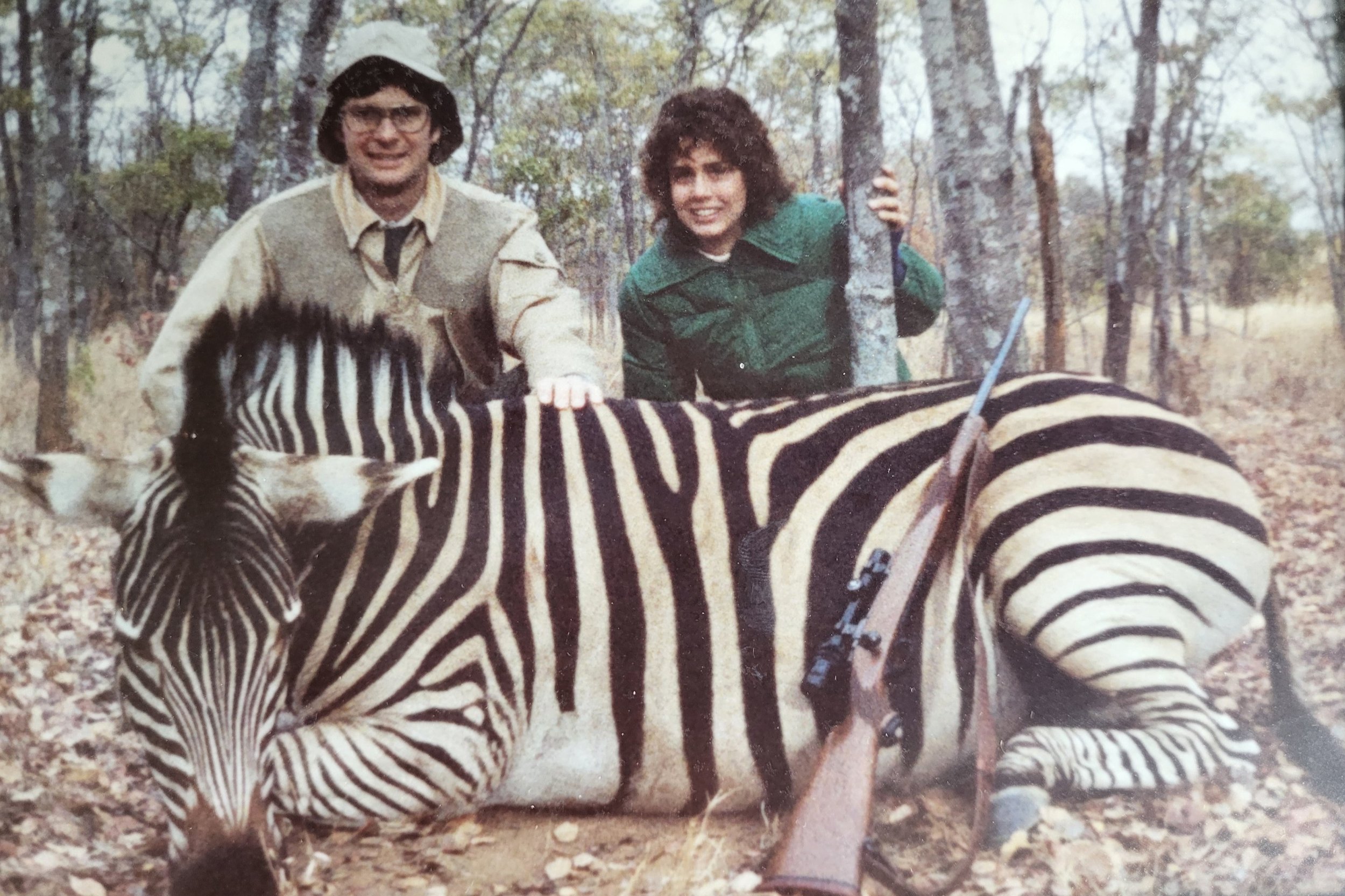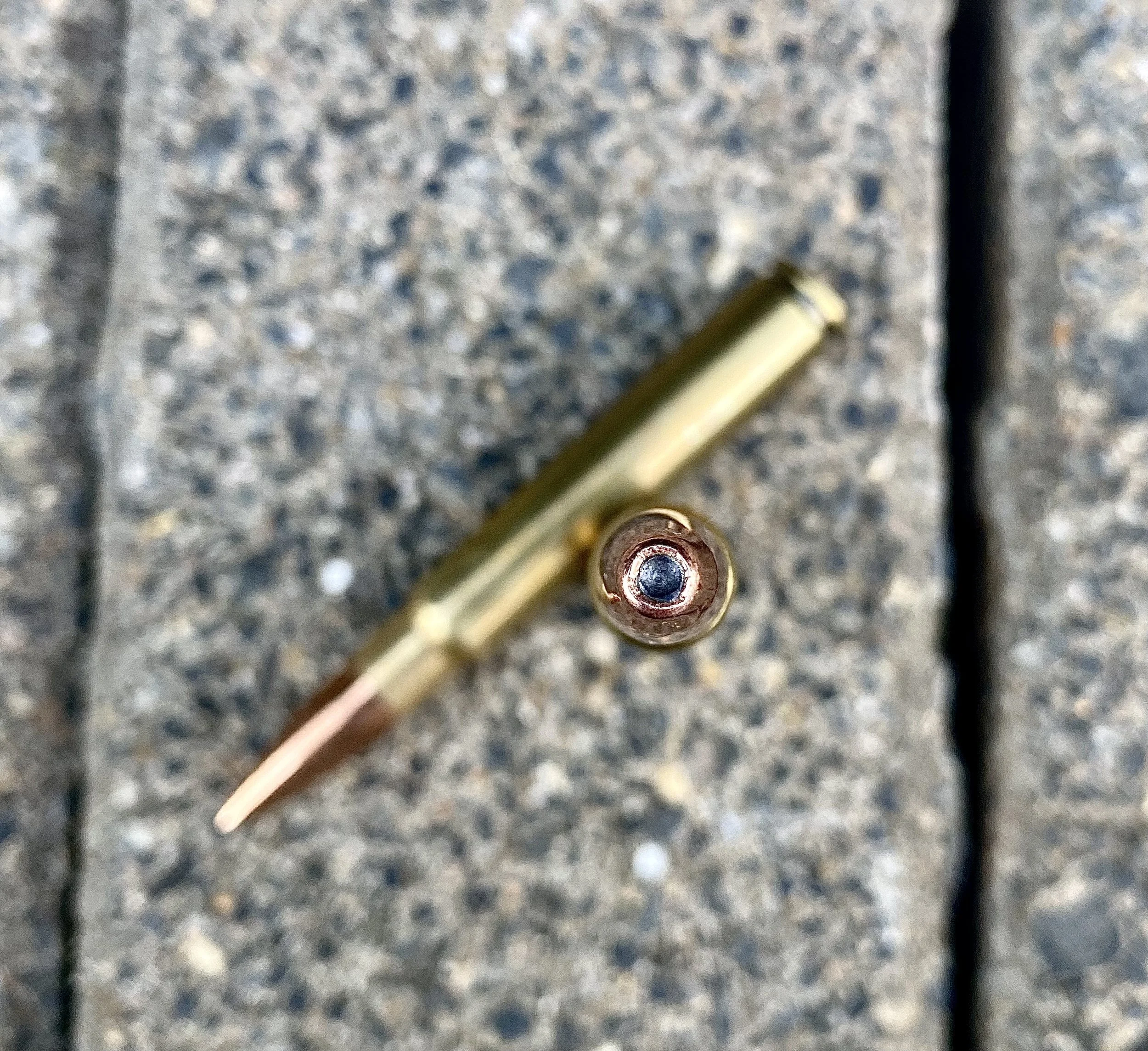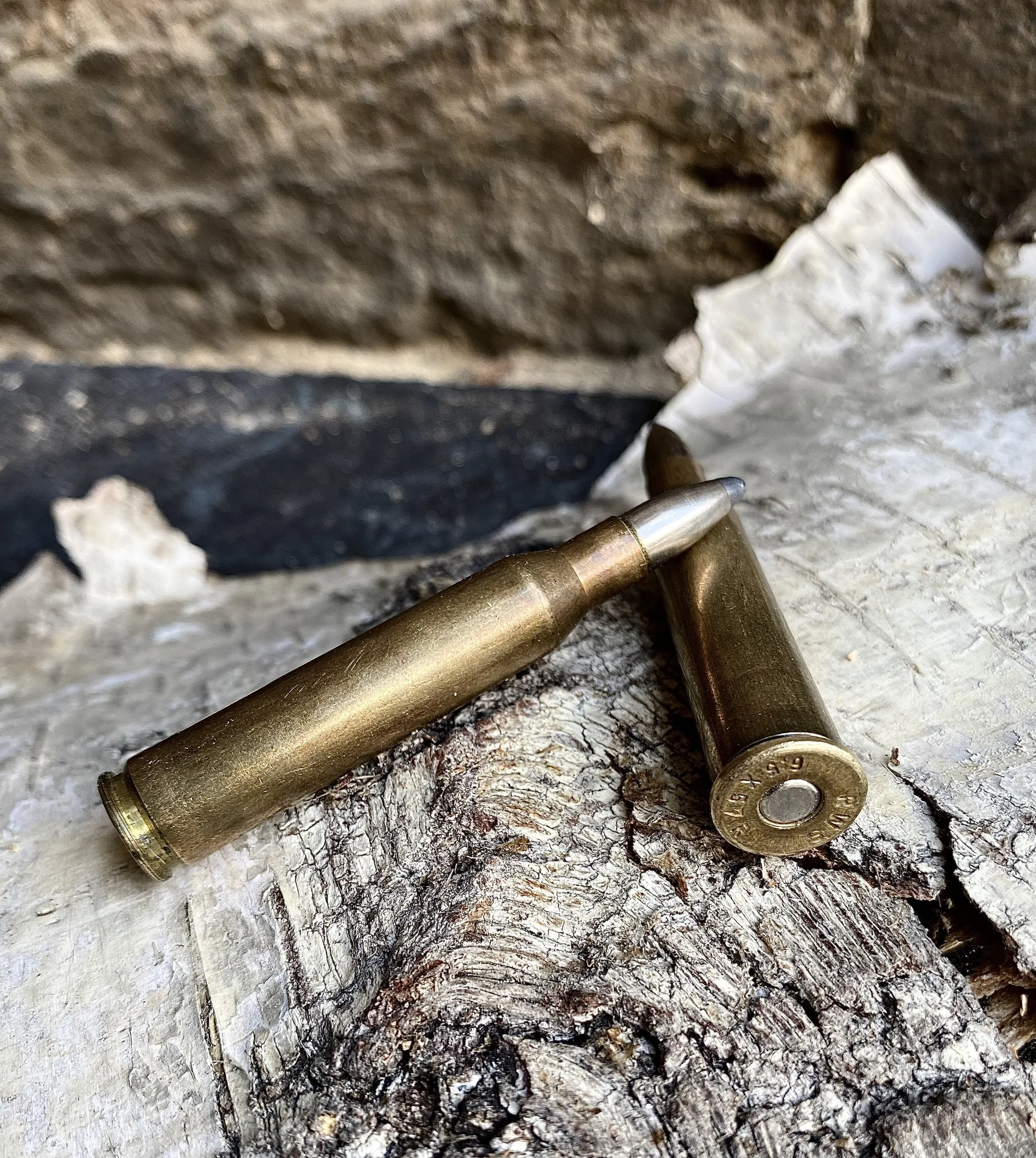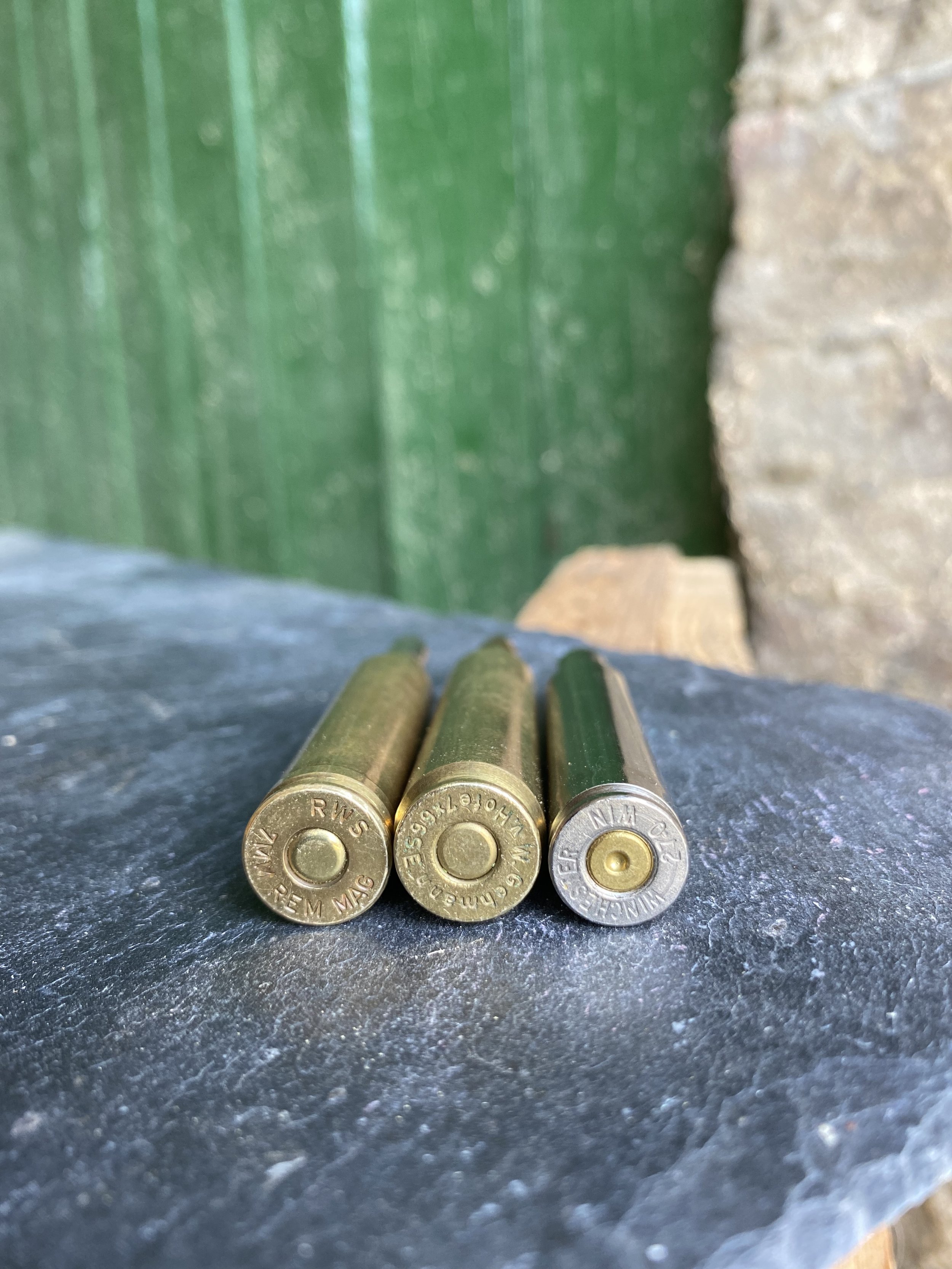257 Weatherby Magnum Rides Again
The under-appreciated 257 Weatherby Magnum has been the heavyweight champ of the lightweight quarter-bore shooting world for 75 years. Yes, the old geezer is still fastest! Roy Weatherby once shot a cape buffalo with one. But that’s not the reason you might want to shoot one. Dramatic terminal performance with minimal recoil is. Oh, and that famous, celebrated, ultra-flat trajectory curve. Hot stuff.
257 Weatherby magnum cartridge and box beside 270 and 300 Weatherby magnums.
257 Weatherby Magnum on left isn't as popular as 270 Weatherby and 300 Weatherby beside it, but more intriguing.
The 257 Weatherby Magnum fits standard, 30-06-length actions
The 257 Weatherby can drive 75-grain bullets 4,000 fps
It pushes 120-grain “deer” bullets 3,200 fps
With less recoil, the 257 can put as much energy on target as a 30-06
Where Roy Found the 257 Weatherby Magnum
Shooting innovator and wildcatter Roy Weatherby found his 257 Weatherby Magnum where he found most of his hyper-drive cases — hiding in a 300 H&H Magnum case. Back in 1944 the belted 300 H&H and and its parent 375 H&H case were the largest, most readily available centerfire cases from which to concoct new cartridges. Winchester made it easy on Roy by manufacturing a cartridge it called the Winchester Super 30. It was simply the 300 H&H under an assumed name. Roy grabbed a handful and began reshaping…
Image shows a 257 Weatherby Magnum cartridge beside a 375 H&H cartridge, the one from which the 257 was formed.
The family resemblance may not be immediately evident -- until you check that belt. The 375 H&H-based case in 1944 was the most readily available brass with a wider body and thus more powder capacity than the 30-06. But more rifles were manufactured with 30-06-length actions. Roy may not have shortened his 257 magnum to fit common actions so much as to balance capacity with the slow burning powders of the day, which weren't all that slow by today's standards. Even at 30-06-action length, the 257 Weatherby is considered an overbore round. But man, what a difference that makes!
Assuming Greatness Under Pressure
Assumptions were and still are a big part of the 375 H&H Magnum belted case and its numerous offspring. Most shooters, for instance, labor under the assumption that the belt somehow strengthens the case against all the incredible power that it’s magnum load of powder must surely produce. In reality, Holland & Holland addd the belt as a secure means of headspacing the round, not trusting the rather shallow, 80 30’ shoulder angle to do the job.
As for pressure, certainly the 375 H&H contains a good bit of it. ANSI rates it for a maximum average breech pressure of 62,000 p.s.i. But the ordinary, everyday, non-belted 270 Winchester and even the little non-belted 22-250 Remington are each rated for 65,000 p.s.i. None of that stopped Roy from taking advantage of high pressured misconceptions. He embraced the trademark Weatherby Belted Magnum as a strengthening agent (for sales anyway) and sailed it to fame and fortune.
Photo shows little 22-250 Remington cartridges beside larger, belted 257 Weatherby Magnums to illustrate there is no need for the belt to contain pressures since the 22-250 is allowed 3,000 p.s.i. more pressure.
Belted against all that pressure? Naw. The little 22-250 Remington is allowed more maximum pressure than the 257 Weatherby, yet is needs no belt. The belt on the extensive 375 H&H Magnum family of cartridges was originally installed to ensure dependable headspacing. The wide, sharp shoulders of the Weatherbys negate the need for the belt, but it was on the original and added a cache of macho that Roy Weatherby rode to fame and fortune.
Belted Back to 257 Weatherby Magnum Reality
These days those belts are looked upon with disdain by more sophisticated shooters who tar them with claims of balky cycling and chamber misaligning inaccuracy. I’m not so sure. More than a century of belted magnum cartridge performance on game around the world — including much dangerous game tackled with the belted big bores from 375 H&H to 458 Lott and 460 Weatherby Magnums — suggests this is much ado about little. The fact that the 300 Winchester Magnum has won 1,000-yard target competitions and that many military snipers have used it to neutralize the enemy at extreme range shoots holes in the inaccuracy claim. Really, I think the worst part about shooting any belted magnum case is putting up with the unfounded criticism.
Photo shows a 257 Weatherby Magnum cartridge against a target showing three holes spreading less than a half inch.
If the headspacing belt on the 257 Weatherby makes it inherently inaccurate, someone forgot to tell the rifle and Weatherby factory load that shot this 100-yard, sub-1/2MOA group. Factory Weatherby Mark V rifle with factory Weatherby
115-grain Nosler Ballistic Tip
bullets.
Belt or no belt, Weatherby shortened the true magnum-length 300 Super case enough so it would cycle in standard, 30-06-length actions. Then he straightened its side walls and pushed the shoulder into his soon-to-be-famous double radius. Finally, he squeezed the neck to grip a .257-inch diameter bullet and bingo! The 257 Weatherby Magnum.
Roy the showman then went on to hype the new round, showcase it, get it in the hands of Hollywood elites (who had a much different attitude toward hunting and guns than do today’s stars of the silver screen.) He hunted with it so much himself that he claimed it was his favorite. Many an elk didn't live to back up that claim.
Still No People’s Choice Awards for 257 Weatherby Magnum
But that was then and this is now. The latest report I could find on gun and ammo sales showed a 2013 popularity ranking for the 257 Weatherby at #91. That compares to #53 for the 25-06 Remington, #19 for the 270 Winchester, and #16 for the lowly 30-30 Winchester! Clearly cartridge popularity hinges on a lot more than ballistic performance because the 257 Weatherby Magnum blasts past all of these and most others on the list. So what gives?
Image shows 257 Weatherby beside more popular 270 Winchester, 25-06 Remington and 30-30 Winchester.
Miss America it isn't. Despite its ballistic performance, mild recoil, and proven game getting power, the 257 Weatherby Magnum limps along far behind th popularity of the 25-06 Remington, 270 Winchester, and even the plebeian 30-30.
Who really knows? Certainly the 25-caliber category hurts. Most hunters in the U.S. figure they need a suitable caliber for deer, which the .25 is, but hope to someday challenge an elk, perhaps even a moose with the distant dream of a big bear or Africa kudu. With such large critters at least a glimmer on the horizon, conservative hunters opt for larger bullet diameters. For decades 30-caliber has been the standard. Many settle for a 7mm magnum, figuring they can save wear and tear on the shoulder without sacrificing terminal performance. In the past few years the crazy success of 26-calibers (6.5 Creedmoor especially) has propelled them into the mix. But 25-caliber? That’s getting too close to varmint bullet diameter, no? Certainly varmint bullet velocities, and that’s another part of the problem…
Photo shows a large herd of elk silhouetted on a purple skyline. The possibility of one day hunting a large deer like this stops many deer hunters from buying a 257 Weatherby.
The potential for an elk on one's horizon has prevented many a hunter to pass the superb 257 Weatherby in favor of a larger caliber -- even if the 257 ultimately delivered more power on target. It's hard to believe the game getting performance of quarter-bore bullets until you've seen it yourself.
Barrel Burner?
The 60- to 70-grains of various powders the 257 Weatherby burns to reach its screaming speeds contribute to the all-too-well-known phenomenon of barrel burning. Yes, this is one of those classic overbore cartridges. It is infamous for burning throats from barrels. Should this worry you? Well, if you want to scorch five rounds down the tube in 30 seconds or rip through a box of 20 in a half hour on a regular basis, maybe. I wouldn’t entertain the 257 Weatherby Magnum as a high-volume varmint or target rifle. But as a hunting rifle in which you might shoot one to three times in an hour, day or week, no problem. A good barrel should last for 1,500 rounds or so before accuracy starts to suffer to any significant extent. And then, like truck tires, you replace the worn out "tread."
But Aren't the Bullets Too Small?
Neither this black bear nor a 3-inch diameter alder limb could stop the 100-grain Barnes TTSX from from its appointed rounds. Rifle is the sleek, handy, break-action Merkel K4 single shot topped with a Swarovski Z3 3-10x42. This rig was a delight to carry in the wet forests of British Columbia under the guidance of Darren DeLuca of Vancouver Island Guide Outfitters.
Well, no. Not really. As Roy Weatherby figured out more than three generations back (and many of us have figured out since,) bullets do not fail or succeed on caliber alone. It is a combination of mass, sectional density, ballistic coefficient, materials, construction, impact velocity, and placement as much as caliber. I once inadvertently shot a bear through a three-inch alder limb with a tiny 100-grain Barnes TTSX launched from a 257 Weatherby Magnum. That wasn't quite the right place, but it sure was the right bullet. It killed the limb and the bear. Thousands of 257 Weatherby Magnum hunters have discovered a proper bullet properly placed spells lights out. And often in dramatic fashion, as the following ballistic data suggest. I’ve included a typical 30-06 deer load for comparison.
257 Weatherby Magnum, 115-gr. Nosler Ballistic Tip
30-06 Govt., 150-gr. Nosler Ballistic Tip
Notice that the 30-06 with its 25-grain additional bullet mass cranks out just 140 f-p more energy than the little 115-grain .257 bullet. But at 300 yards the little .257 has just about pulled even. At 400 yards it’s slightly ahead. Combine that with about 40 more yards of MPBR on a seven-inch target and this little quarter-bore isn’t looking like such a lightweight. Of course, you can shove 180-grain bullets down the 30-06 for more downrange whump, but at the cost of more recoil and drop.
Getting a Kick Out of 257 Weatherby's Twisted Ways
By the way, the above loads in an 8-pound rifle recoil with about 21 f-p and 22.4 f-p energy respectively. The 180-grain 30-06 load would punch about 26 f-p on your shoulder and a 300 Win. Mag. would run closer to 30 f-p.
As you might be thinking at this point, the 257 Weatherby’s real weakness is a shortage of premium, high B.C. bullets. While 7mm and 6.5mm bullets have been stretched into the mid .6s for B.C., the .257s are stuck in the mid .4s at best. That's beginning to change. Blackjack bullets is building the 131-grain Blackjack ACE rated G7 B.C. .330. That should equal roughly .650 G1 B.C., so let’s see how it flies. Blackjack claims they can get 3,300 with a hot load in a long barrel, but let’s be conservative and settle for handloads hitting 3,200 fps. You need a 1-8, perhaps 1-7.5 twist to stabilize this, and that's the final piece of the puzzle. You'll need a custom barrel to find twist rates that steep.
Photo shows a stack of aftermarket bullet boxes holding a wide variety of 80- to 120-grain bullets for the 257 Weatherby.
There are plenty of bullets sold in .257, but no truly modern, sleek, long, heavy-for-caliber, high B.C. bullets suitable for big game. That is the one road block hampering increased popularity for the 257 Weatherby. New offerings from
promise to fix that. You'll need fast, 1-8" twist rifling to stabilize them.
257 Weatherby Magnum, 131-gr. Blackjack ACE
While this one doesn’t quite match the starting energies of the other two, notice how that high B.C. bullet conserves it. The results is about 300 f-p more energy at 400 yards. And MPBR is still about 340 yards.
This MPBR thing is nice when you need to shoot quickly at unknown distances. That’s the way we all did it pre-laser rangefinder. If you know your bullet will not rise more than 3.5 inches above your line-of-sight nor fall 3.5 inches below it, you can hold dead center on a deer’s chest and know you’ll strike the pumping station. I took advantage of this while targeting my biggest Coues buck at what proved to be 351 yards. Dead-on hold, heart shot, done and done.
Once we, too, were young. In 1999 a
in 257 Weatherby (featuring Lex Webernick's typical precision workmanship) delivered a 100-grain Barnes TTSX to the heart of this spectacular Sonora, Mexico, Coues buck from 351 yards out. Leica scope and binocular augmented my view and directed traffic.
Does 257 Weatherby Magnum Really Strike Like Bolt of Lightning?
Users often claim the 257 Weatherby hits like a bolt of lightning, and it often does. But let's be real. No .257” bullet of any length/mass will necessarily terminate game with the authority of a wider, longer, heavier slug at the same impact velocity. But neither is the 257 Weatherby Magnum just a puny varmint round. It was, is, and always will be an incredibly effective deer/sheep/pronghorn/goat/black bear cartridge with enough, and probably more than enough, oomph for elk and moose. With the right controlled expansion bullet, I wouldn’t hesitate to hire it to engage oryx, wildebeest, kudu or anything of similar size and build in Africa.
Author with a pronghorn taken with a Weatherby MV rifle in 257 Weatherby Magnum topped with Swarovski Z3 3-10x42 scope.
The 257 Weatherby Magnum might not strike like a bolt of lightning every time, but the bullet that flattened this New Mexico pronghorn must have been going so fast it melted those horns on the way to the landing. The exact bullet is lost to the mists of time, but I think it was the 115-grain Ballistic Tip load from Weatherby. That's pretty obviously a synthetic-stock Weatherby Mark V rifle with fluted barrel with what appears to be a Swarovski Z3 3-10x42, a scope I've used many, many times on many, many rifles. This hunt was enjoyed in the company of my good friend Brad Ruddell, always a good man with whom to ride the river!
Got the Audacity to Try 257 Weatherby?
Clearly the 257 Weatherby isn't for everyone. But it might be perfect for you. If you've put a few deer in the freezer and have trained to shoot calmly and well, you might discover the cartridge you've been waiting for your whole life. And even if not, you'll reckon it's a darn good second place.
Spomer has enjoyed one-shot kills on whitetails, Coues deer, black bears, and coyotes with various 257 Weatherby Magnums. Now he's hoping someone will send him on an all expense paid safari to try it on kudu, sable, roan, nyala, eland...




